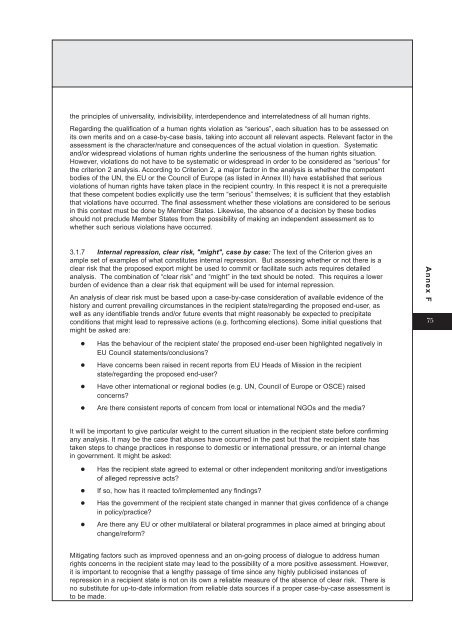Annex A - Official Documents
Annex A - Official Documents
Annex A - Official Documents
Create successful ePaper yourself
Turn your PDF publications into a flip-book with our unique Google optimized e-Paper software.
the principles of universality, indivisibility, interdependence and interrelatedness of all human rights.<br />
Regarding the qualification of a human rights violation as “serious”, each situation has to be assessed on<br />
its own merits and on a case-by-case basis, taking into account all relevant aspects. Relevant factor in the<br />
assessment is the character/nature and consequences of the actual violation in question. Systematic<br />
and/or widespread violations of human rights underline the seriousness of the human rights situation.<br />
However, violations do not have to be systematic or widespread in order to be considered as “serious” for<br />
the criterion 2 analysis. According to Criterion 2, a major factor in the analysis is whether the competent<br />
bodies of the UN, the EU or the Council of Europe (as listed in <strong>Annex</strong> III) have established that serious<br />
violations of human rights have taken place in the recipient country. In this respect it is not a prerequisite<br />
that these competent bodies explicitly use the term “serious” themselves; it is sufficient that they establish<br />
that violations have occurred. The final assessment whether these violations are considered to be serious<br />
in this context must be done by Member States. Likewise, the absence of a decision by these bodies<br />
should not preclude Member States from the possibility of making an independent assessment as to<br />
whether such serious violations have occurred.<br />
3.1.7 Internal repression, clear risk, "might", case by case: The text of the Criterion gives an<br />
ample set of examples of what constitutes internal repression. But assessing whether or not there is a<br />
clear risk that the proposed export might be used to commit or facilitate such acts requires detailed<br />
analysis. The combination of “clear risk” and “might” in the text should be noted. This requires a lower<br />
burden of evidence than a clear risk that equipment will be used for internal repression.<br />
An analysis of clear risk must be based upon a case-by-case consideration of available evidence of the<br />
history and current prevailing circumstances in the recipient state/regarding the proposed end-user, as<br />
well as any identifiable trends and/or future events that might reasonably be expected to precipitate<br />
conditions that might lead to repressive actions (e.g. forthcoming elections). Some initial questions that<br />
might be asked are:<br />
� Has the behaviour of the recipient state/ the proposed end-user been highlighted negatively in<br />
EU Council statements/conclusions?<br />
� Have concerns been raised in recent reports from EU Heads of Mission in the recipient<br />
state/regarding the proposed end-user?<br />
� Have other international or regional bodies (e.g. UN, Council of Europe or OSCE) raised<br />
concerns?<br />
� Are there consistent reports of concern from local or international NGOs and the media?<br />
It will be important to give particular weight to the current situation in the recipient state before confirming<br />
any analysis. It may be the case that abuses have occurred in the past but that the recipient state has<br />
taken steps to change practices in response to domestic or international pressure, or an internal change<br />
in government. It might be asked:<br />
� Has the recipient state agreed to external or other independent monitoring and/or investigations<br />
of alleged repressive acts?<br />
� If so, how has it reacted to/implemented any findings?<br />
� Has the government of the recipient state changed in manner that gives confidence of a change<br />
in policy/practice?<br />
� Are there any EU or other multilateral or bilateral programmes in place aimed at bringing about<br />
change/reform?<br />
Mitigating factors such as improved openness and an on-going process of dialogue to address human<br />
rights concerns in the recipient state may lead to the possibility of a more positive assessment. However,<br />
it is important to recognise that a lengthy passage of time since any highly publicised instances of<br />
repression in a recipient state is not on its own a reliable measure of the absence of clear risk. There is<br />
no substitute for up-to-date information from reliable data sources if a proper case-by-case assessment is<br />
to be made.<br />
<strong>Annex</strong> F<br />
75

















